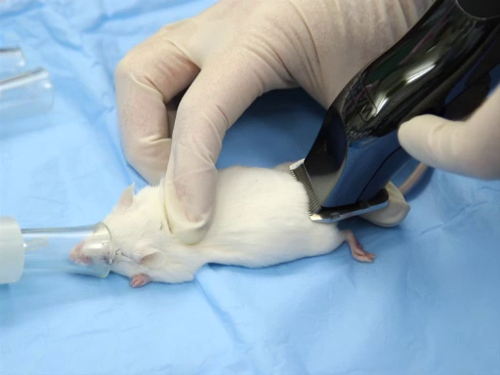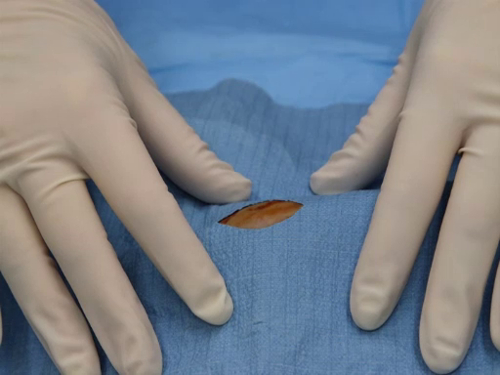1. 和 #160;P resurgical 规划
虽然准则不要求在专用的外科手术设备中进行啮齿动物手术, 但使用的区域必须用适当的硬表面进行消毒消毒剂, 应按照制造商和 #39 的浓度和接触时间使用。该地区也应保持无杂波, 而不是在直接线的供应和排气管道, 因为草案可能导致低温的动物。在进行手术时, 应限制进入房间。外科准备 (特别是切除动物和 #39 的毛发), 以及术后恢复和护理的区域, 也应该在靠近的地方, 如果不在手术室内。一般而言, 如果手术是在某一特定区域例行进行的, 则该区域不应用于其他活动.
术前准备应包括对外科病人进行体格检查, 以确定可能影响手术的任何潜在的健康状况。由于啮齿类动物有如此高的新陈代谢率, 而且脂肪储备非常有限, 所以在手术前不应禁食。动物和 #39 的水化状态应通过皮肤弹性试验来评价。肩部上方的皮肤被轻轻举起。在一个通常是水合的动物, 皮肤会迅速回落到位, 而在脱水的动物, 皮肤不会立即回到它的正常位置。整体外观, 如姿势和毛发的状况, 也应注意。一个动物, 显示一个驼背的姿势, 或有一个蓬乱的毛大衣, 可能是窝藏疾病。检查应在麻醉前进行, 在动物和 #39 的病历中应注明任何异常情况。 2 最后, 在为手术做准备时, 必须考虑老鼠或老鼠的解剖和生理学.
2. 平台
两个物种都有一个高的表面积, 以身体容积比, 使他们容易低温在手术过程中, 特别是当手术暴露体腔。防止体温过低的措施包括使用加热的手术平台.
用于啮齿动物手术的平台, 通常由不锈钢或硬质塑料制成, 必须用绝缘材料或补充热源覆盖, 以防止动物和 #39; 从逃逸的身体热量程序.补充热源包括水循环加热垫, 强迫 air-warming 毯, 热灯, 或一层泡沫填料覆盖的手术平台。具有内置热源的外科手术平台可供商业使用。所有的平台必须是一种易于消毒和防潮的材料.
防止体温过低的其他方法包括使用质量绝缘体, 在动物和手术平台之间放置绝缘材料, 以及使用外部热源。 3 质绝缘子在纤维基质内诱捕空气, 产生和 #34; 静止的空气和 #34; 包围动物。在病人下面可以使用循环热水毯。这种设备可从啮齿动物到马的各种大小, 并允许精确的热支持与内置恒温器. #160;
化学激活的加热源既可以一次性使用, 也可重用。一个类型包括一个塑料袋充满了化学溶液和金属盘, 当按下创建一个放热的反应。这会使液体凝固并释放热量。一般来说, 它们的热量有限, 只适用于短流程。其他化学热源可作为固体在室温下, 但当加热时, 它们变成液体。当动物被放在垫子上时, 液体释放热量, 而垫子的内容在冷却时凝固。这些可以在更长的时间内释放热量。作为一种好处, 他们不能超过激活温度 (〜39和 #176; C), 从而消除了对恒温器的需要.
水包可作为热水壶, 由橡胶或硅胶袋和塞子组成。这些包里装满了热水, 然后在外面的表面散发热量。当水冷却下来时, 包将逐渐失去热量。一个更现代的版本包括一个塑料板与透水织物坚持顶部。之间的空间充满了亲水性粉末, 吸收水和膨胀。它可以作为热源或者冷却源使用。根据材料的质量, 可以在微波炉中重复使用或再加热或浸泡在热水中.
使用外部热源时必须采取预防措施。体温应该用直肠探针或体温计放置在热源旁边的温度计来监测。所有外部热源必须在使用前检查是否有缺陷. 和 #160;
3。脱毛
手术部位必须做好准备, 以尽量减少切口的污染。头发应该是紧密修剪或去除与化学脱毛奶油, 溶化头发在卵泡。 23 虽然有时可以在有意识的动物身上进行修剪, 但脱毛膏的应用只应在麻醉动物身上进行, 以防止产品的摄入、眼部损伤和去除多余的头发。如果没有其他选择, 用剃刀剃须是一种选择。这种方法需要技术技能, 额外的时间和耐心, 以防止撕裂皮肤。手术场应足够大, 以允许切口和缝合不包括毛皮进入外科伤口, 但尽可能小, 以避免恶化的低温.
- 修剪
- 头发可以使用有线电动或电池操作剪刀修剪, 最好是用外科 A40 刀片。刀片的宽度应考虑。标准的2和 #34; 刀片可用于大鼠, 而 #189;-1 和 #34; 刀片更适合于鼠标.
- 头发在生长的方向被修剪。伸展皮肤以稳定它, 因为啮齿动物有松散的皮肤附着在底层肌肉上.
- 必须注意避免偷或切割皮肤。修剪头发时, 刀刃的扁平端被放在皮肤上。刀片不应与与皮肤垂直的牙齿使用.

图1。剃须时头发剪的正确位置.
- 化学脱毛膏或乳液
- 将该产品应用于外科手术部位.
- 10 分钟后, 皮肤必须完全冲洗干净d 和清洁的脱毛的所有痕迹, 以避免刺激或化学灼伤皮肤.
4。外科手术磨砂
要使用的外科擦洗解决方案应: 1) 大大减少皮肤上存在的微生物, 并含有无抗菌制剂;2) 具有抗菌性能 broad-spectrum;3) 动作快;和 4) 有持续的, 累计的活动.
两种常用的清洁擦洗解决方案是 chlorhexidines 和碘。氯己定溶液对细菌和病毒有效, 即使在有机物质存在。相比之下, 碘有广泛的微生物作用, 但其功效在有机物质的存在下减少;剩余活动小于 chlorhexidines.
冲洗使用之间的磨砂不是无菌水或酒精。含60-95% 乙醇的醇类溶液通过蛋白质的变性有很大的抗菌作用。 2 然而, 酒精可以是一种强烈的皮肤刺激性。无菌水是有效的冲洗面积, 但它没有任何抗菌性能.
- 使用湿纱布海绵清除包括毛发和毛屑在内的总碎片.
- 浸泡在纱布垫上的防腐清洗液应用于从切口部位开始的皮肤。消毒应沿切口线开始, 并向外延伸.
- 杀菌冲洗从切口部位开始应用。皮肤被从切口线螺旋形的圆形图案擦拭到外科手术场的外围, 以去除清洁液.
- 此重复三次.
- 最后冲洗后, 在手术场上放置无菌纱布垫。这纱布可能是用酒精或碘湿的。一旦动物被运送并放置在外科手术台上或手术台上或长凳上, 纱布将被移除.
不使用标准的手术洗涤方法的身体区域包括眼睛、嘴巴和肛门区域。由于眼睛的表面会被破坏, 如果使用磨砂解决方案, 手术磨砂只做的眼睑后, 向眼睛灌输了保护性软膏。在某些情况下, 一个生理平衡的盐水溶液被用来冲洗眼睛, 以消除总的碎片和稀释任何细菌到一个水平可以接受的手术发生。口腔也证明难以充分清洁手术。它可以用生理平衡的生理盐水冲洗, 以稀释任何细菌;然而, 重要的是要避免使用过多的盐水, 这可能会引起液体的愿望。牙龈、牙齿和舌头可以用无毒的防腐剂擦拭。然而, 应用溶液的黏膜可以导致系统性的吸收。肛门区域的手术, 如直肠垂的手术复位, 不被认为是清洁手术。使用一些防腐溶液可以增加组织损伤, 防止或延长愈合。使用一种生理平衡的盐水溶液清洗总碎片的面积是首选的手术方法。 24
5。定位
腹部手术病人的定位包括用胶带或绷带将俯卧的动物的四肢固定在平台上。当用绷带伸展四肢时, 必须注意防止脚部的血液循环受到损害, 避免四肢过度紧张和四肢的极度伸展, 从而损害关节, 避免呼吸障碍。领带应该是一个快速的释放, 只有一个半顺利循环的肢体。一些商用平台的内置肢体收回, 包括钩或不锈钢线或球链环, 可以根据动物的大小来调整。如果使用胶带, 必须将其附着在干燥的表面上.
6. 悬垂
一旦动物准备就绪并放置在手术台上, 手术用的窗帘可以防止缝合材料的污染, 并在外科手术部位维持一个无菌场。窗帘可以是可重复使用的布料材料、一次性纸张材料或一次性塑料粘合材料.
一次性纸窗帘有一个编织纤维矩阵的力量, 允许切割成任何形状或大小, 包括切割开窗或在悬垂, 不撕裂或磨损的边缘。它们也是防潮剂。一次性窗帘可以购买预先包装和 presterilized 的各种大小和形状。布帘的设计不是由外科医生切开的, 以创建一个开窗。他们购买的预制和绑定边缘开窗。布帘需要清洗和消毒。当照顾好, 布窗帘可以持续多年, 这使他们的经济投资.
纸和布窗帘都是用毛巾钳固定在动物的皮肤上, 如果它是一个较大的啮齿动物, 如成年老鼠。对于较小的啮齿动物, 没有贴在皮肤上, 这需要在外科医生的警觉和护理, 以不驱逐或转移的褶皱, 一旦它已经定位在动物身上.
粘接窗帘是透明的, 也可以是半透明的。明确的窗帘是首选的啮齿动物手术, 因为他们允许直接可视化的动物。一些塑料窗帘是塑料和纸的组合, 塑料区域直接地在动物和纸区域定义延长的无菌领域。直接在手术切口部位的褶皱部分设计为附着在切口部位。外科医生在做皮肤切口时可以直接通过塑料切开。灭菌塑料包装已被视为 cost-effective 和有用的材料, 为啮齿类动物手术。在病人周围放置包裹时, 必须注意避免呼吸动作的收缩。包装将保存体温, 允许病人可视化, 并在无菌场和动物之间提供一个防潮屏障。它也可以帮助在动物的定位和持有的手术代替肢体固定.
任何类型的窗帘都应小心地展开, 以避免与菌区域、设备和人员接触; 它们不应该通过摇动或挥舞来展开.
- 纸帘: 在单张悬垂方法中, 如果不预制, 则展开褶皱以允许切口开窗。
- 外科医生会将悬垂在动物身上的褶皱放置在不会触及病人的褶皱的一侧.
- 对褶皱进行调整, 使手术场通过开窗可见.
- 在大鼠的情况下, 用毛巾夹在动物的皮肤上进行褶皱.
- 带粘附窗口的纸张或塑料
- 带有粘附窗口的悬垂性要求剥离纸张区域, 以允许胶粘剂区域粘附到外科领域.
- 当展开无菌的褶皱时, 粘合剂区通常是最上部的区域, 便于外科医生使用.
- 一旦粘合剂被揭开, 褶皱就会被仔细地展开并转动, 这样黏糊糊的一面就会朝向动物.
- 必须正确放置褶皱, 因为一旦粘合剂与动物接触, 就无法进行调整.
- 外科医生应该蚊按粘合剂的外科领域, 以创建一个密封的皮肤.
- 布帘
- 内皮布帘不被切割, 因此它是外科医生和 #39; 有责任选择一个足够大的开口的褶皱, 充分暴露手术区, 但不太大, 允许暴露任何刮和无准备的身体表面.
- 该悬垂是仔细展开的, 以显示开窗.
- 外科医生会将悬垂物放在动物身上, 将手放在不触及病人的褶皱的一侧.
- 对褶皱进行调整, 使手术场通过开窗可见.

图2。通过一个正确放置的褶皱的开窗可见的外科领域.
- 粘合窗帘: 用于啮齿类手术的 cost-effective 和有用的材料. 5
- 必须以某种方式从卷中拉出褶皱, 以确保使用的剖面保持不育.
- "外科助手" 打开该框并拉出一个长度的包装, 小心避免触摸到盒子或任何其他表面.
- 外科医生在每一侧都能掌握包裹, 而助手则会切断他们所持有的 (大约3-4 英寸) 的末端.
- 丢弃切口边缘后, "助手" 还会从该卷的其余部分剪切该节.
- 外科医生掌握了包装的一侧, 并把它放在动物身上.
- 自动换行的属性允许它粘附到所有曲面.
- 外科医生把胶片压在动物身上, 制造出一个不育的领域.
- 无需使用毛巾夹或担心褶皱会移位.
- 必须注意避免呼吸运动的收缩。包装将保存体温, 允许病人可视化, 并在无菌场和动物之间提供一个防潮屏障.
7。术中监测
麻醉病人必须监测体温、呼吸和心率, 直到完全恢复.
体温可以直接或间接监测。为了直接监测, 必须使用专门为啮齿动物设计的直肠探针。小动物直肠温度计, 无论是水银或数字, 都太大, 不能用于小鼠和大鼠肛门括约肌和直肠组织的损伤。在易感菌株, 其使用可能会沉淀直肠脱垂。间接监测涉及放置一个温度计旁边的动物或身体下的外部热源。虽然这不会给出一个确切的体温, 它可以表明热源的有效性, 并允许调整, 以减少或增加热量的需要.
在没有专门设备的小鼠身上, 很难听诊心率和计数呼吸.
大多数监视是可视的, 只显示胸部或腹部呼吸的存在或缺失。通过触诊或目测观察胸壁的细微运动, 可以评估心率。这可能是不可能的, 在手术中由于悬垂和小规模的动物.
通过使用心电图和脉冲血可以进行额外的监测。心电图和 #39 在麻醉和手术中评估啮齿动物的心脏状况。脉冲血使用红光和红外线光折射来测量动脉血中的氧。这种技术已经适应了使用在啮齿动物的尾巴或爪子。这两种类型的无创持续测量的病人和 #39 的生命体征很容易获得的外科领域的干扰最小.
8. 术后监测
应考虑在恢复笼 postsurgery 下使用加热垫。此外, 应尽可能提供先发制人和术后镇痛。镇痛的规定是最有效的, 以减少疼痛刺激的强度时, 在痛苦的事件之前。先发制人地使用镇痛药的好处包括减轻疼痛刺激的强度, 改善动物和 #39; 舒适水平 postsurgery, 减少了维持手术平面所需的麻醉量, 以及手术结束后从麻醉中恢复顺畅。通常使用的先发制人和术后药物见表1。 6
| 毒品类 | | 添加 频率 |
| 非甾体抗炎药 (Noncontrolled 物质) | 洛芬 | 2-5 毫克/千克 sc 小鼠 5 毫克/千克 sc 鼠
| 每隔 12 #8211; 24 小时 每 12 #8211; 24 小时
|
非甾体 anti-inflammatory 药物 (Noncontrolled 物质) | 尼辛葡胺 | 2.5 毫克/千克 SC 小鼠 | 每12和 #8211; 24 小时 |
| 非甾体抗炎药 (Noncontrolled 物质) | 昔 | 5-10镁/千克小鼠或1-2 毫克/千克 sc 小鼠
5-10 毫克/千克 po 或1-2 毫克/千克 sc 或 PO 鼠 | 每12和 #8211; 24 小时
每24小时
每 12 #8211; 24 小时
每24小时 |
| 非甾体抗炎药 (Noncontrolled 物质) | 醋氨酚 | 50 毫克/千克 SC/IP 或100毫克/千克大鼠 | 每 8 #8211; 12 小时 |
| 阿片类药物 (受控物质) | 啡 | 0.5-3.0 毫克/千克 SC 或 0.2-2 毫克/千克 IP 和 #160; 鼠标
2.0 毫克/千克 SC
0.2-2 毫克/千克 IP 鼠 | 每4小时
每 2 #8211; 4 小时
每4小时
每隔 2 #8211; 4 小时 |
| 阿片类药物 (控制物质) | 丁丙诺啡 | 0.05-2. 5 毫克/千克 SC 或 IP 小鼠
0.01 和 #8211; 0.5 毫克/千克 SC 鼠 | 每隔 6 #8211; 12 小时和 #160;
每 8 #8211; 12 小时 |
| 阿片类药物 (受控物质) | Oxymorphone | 0.2-0.5 毫克/千克 sc 鼠
0.2-0.5 毫克/千克 sc 鼠 | 每6和 #8211; 12小时
每 6 #8211; 12 小时 |
表 1. 常用的先发制人和术后用药.
















